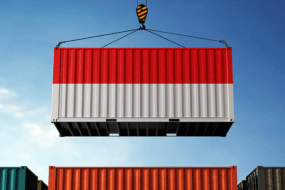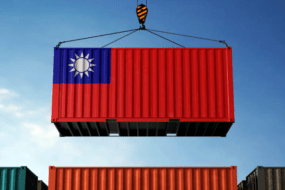- Home
- Trade News
- Challenges & Opportunitie ...

Table of Contents
- Introduction
- Slower Export Growth
- Trade Deficit Dynamics
- Impact of Geopolitical Tensions
- Economic Contraction
- Monetary Policy Conundrum
- Inflation and Consumer Behavior
- Conclusion
Introduction
In the land of the rising sun, Japan’s economic landscape in October offered a glimpse into a nation grappling with the complexities of post-pandemic recovery. The headlines spoke of both challenges and opportunities and in this blog post, we delve into a comprehensive analysis, offering insights into the factors shaping Japan’s economic trajectory.
Slower Export Growth
October witnessed a slowdown in Japan’s export growth, with a modest 1.6% increase compared to the previous month’s 4.3% surge. While this deceleration was less than anticipated, it reflects the broader global economic uncertainty. Supply chain disruptions, escalating raw material costs, and ongoing trade tensions cast shadows over Japan’s export-oriented economy. Key sectors, such as automotive, shipping, and construction machinery, are feeling the effects of these headwinds.
Trade Deficit Dynamics
Japan’s trade balance swung into deficit territory, registering 662.5 billion yen (S$5.9 billion). A trade deficit can raise eyebrows, as it indicates that the nation imported more than it exported during the period. The 12.5% decrease in imports could be attributed to various factors, including supply chain bottlenecks and potential softness in domestic demand. Policymakers are now tasked with addressing these challenges to restore equilibrium to trade dynamics.
Impact of Geopolitical Tensions
The spectre of geopolitical tensions looms large. Conflicts in the Middle East and Ukraine have sent ripples through global commerce, and Japan is not immune. These tensions can disrupt supply chains and international trade, potentially dampening Japan’s export prospects. Skillful diplomacy and proactive risk management are crucial in navigating these uncertain waters.
Economic Contraction
Japan’s GDP contracted at an annualized rate of 2.1% in the third quarter, surpassing economists’ expectations of a 0.4% contraction. Reduced business spending and increased imports were key contributors to this sharper-than-expected decline. This contraction underscores the fragility of Japan’s economic recovery and highlights the urgent need for measures to boost domestic demand and encourage investment.
Monetary Policy Conundrum
The Bank of Japan (BOJ) remains cautious in its monetary policy approach. BOJ Governor Kazuo Ueda emphasizes the need for clear signs of sustained inflation and economic growth before considering a policy shift. However, the delicate economic situation may prompt debates about the timing of potential adjustments. The central bank’s decisions play a pivotal role in shaping Japan’s economic trajectory, and they warrant close attention.
Inflation and Consumer Behavior
Persistent inflationary pressures and stagnant wage growth have put a damper on consumer spending in Japan. This poses a significant challenge to the nation’s economic recovery, as it could lead to reduced consumer confidence and spending. Prime Minister Fumio Kishida’s call for businesses to raise wages signifies the government’s recognition of this issue and its efforts to stimulate consumer demand.
How Trade Data Can Help
Trade data plays a crucial role in helping governments, businesses, economists, and policymakers make informed decisions and understand the economic landscape. Here are some ways trade data can be valuable for Japan:
- Economic Analysis and Planning:
- Economic Growth Assessment: Japan’s Trade data helps assess Japan’s economic health. Increasing Japanese exports often indicate economic growth, while Japan’s trade deficits may signal imbalances.
- Policy Formulation: Japanese governments use trade data to formulate trade policies, tariffs, and regulations that can stimulate economic growth, protect domestic industries, and ensure trade balance.
- Resource Allocation: Japanese businesses and governments can allocate resources more efficiently by analyzing which industries are performing well in international markets.
- Global Supply Chain Management:
- Supply Chain Optimization: Japanese companies use Japanese trade data to optimize their supply chains by identifying key suppliers and markets, reducing lead times, and minimizing transportation costs.
- Risk Mitigation: Japan Trade data helps Japanese businesses anticipate and mitigate supply chain disruptions due to factors like geopolitical tensions, natural disasters, or transportation issues.
- Market Research and Expansion:
- Market Identification: Japanese companies can use trade data to identify new markets with potential demand for their products or services.
- Competitive Analysis: Analyzing Japanese trade data can help Japanese businesses understand their competitors’ market share, pricing strategies, and distribution channels.
- Policy Evaluation and Negotiation:
- Trade Negotiations: Governments and trade negotiators use trade data to identify areas of strength and weakness in their trade relationships and to negotiate favourable trade agreements.
- Policy Evaluation: Trade data helps assess the impact of trade policies and agreements on various industries and the overall economy.
- Investment Decisions:
- Foreign Direct Investment (FDI): Investors can use Japanese trade data to identify countries or regions with strong trade relations, indicating potential opportunities for FDI.
- Risk Assessment: Japan’s trade data can help assess the stability of a region or country for investment by considering factors like trade balance and political stability.
- Currency and Exchange Rate Analysis:
- Exchange Rate Predictions: Japan’s Trade data can influence currency exchange rate forecasts. A trade surplus may strengthen a country’s currency, while a deficit may weaken it.
- Currency
Click here to visit our blogpost on all essential tools and resources for businesses: https://blog.tradedata.pro/essential-tools-and-resources-expanding-your-business-2023/
Your Trusted Source for Trade Data: TradeData.Pro.
Trade Data Pro stands as a beacon of reliability in the sphere of trade data, originating from the economically robust and politically stable environment of Singapore. This esteemed platform is a brainchild of the Commodities Intelligence Centre, a notable government-linked entity and a synergistic joint venture involving Zall Smartcom, Singapore Exchange (SGX), and Global eTrade Services (GeTS). Since making its debut in 2018, Trade Data Pro has garnered acclaim for its expansive coverage, cost-effectiveness, and swift response time, earning prestigious accolades such as the Singapore Quality Class (2020), Stevie Award Gold (2021), Crozdesk 2023 Happiest Users Award, 2023 Slashdot Top Performer, and 2023 Source Forge Top Performer.
With widespread recognition, Trade Data Pro has been spotlighted in numerous reputed news outlets, including Bloomberg, Business Times, MarTech Series, ACN News, and more, further cementing its status as a reputable source in the industry. User satisfaction remains paramount, reflected by stellar average ratings of 5 stars on leading review platforms like SourceForge, Capterra, G2, and others. This unanimous user acclaim speaks volumes about the platform’s unyielding commitment to quality and customer satisfaction.
In a world where procuring pivotal data for unmasking trends, pinpointing market openings, keeping tabs on the competitive landscape, and comprehending supply chain potential has traditionally been daunting, Trade Data Pro simplifies this endeavour. The platform meticulously collates and curates shipment data mandated by governmental import-export filings, presenting it as actionable business intelligence. This treasure trove of information facilitates a crystal-clear understanding of goods movement across international borders and is encapsulated within the largest searchable trade database globally available.
For businesses eyeing the vibrant Vietnamese industry, TradeData.Pro offers up-to-the-date data. Engage with our intuitive platform to discover products that align with your interest by exploring our trade database demo: Vietnam Import Export Data. For historical insights into penetrating new markets, kindly visit our Trade Database Demo.
For a dynamic understanding of our platform’s operations, view the video linked below or visit YouTube. With Trade Data Pro, you’re not just accessing data; you’re unlocking a gateway to informed, strategic global trade decisions.








